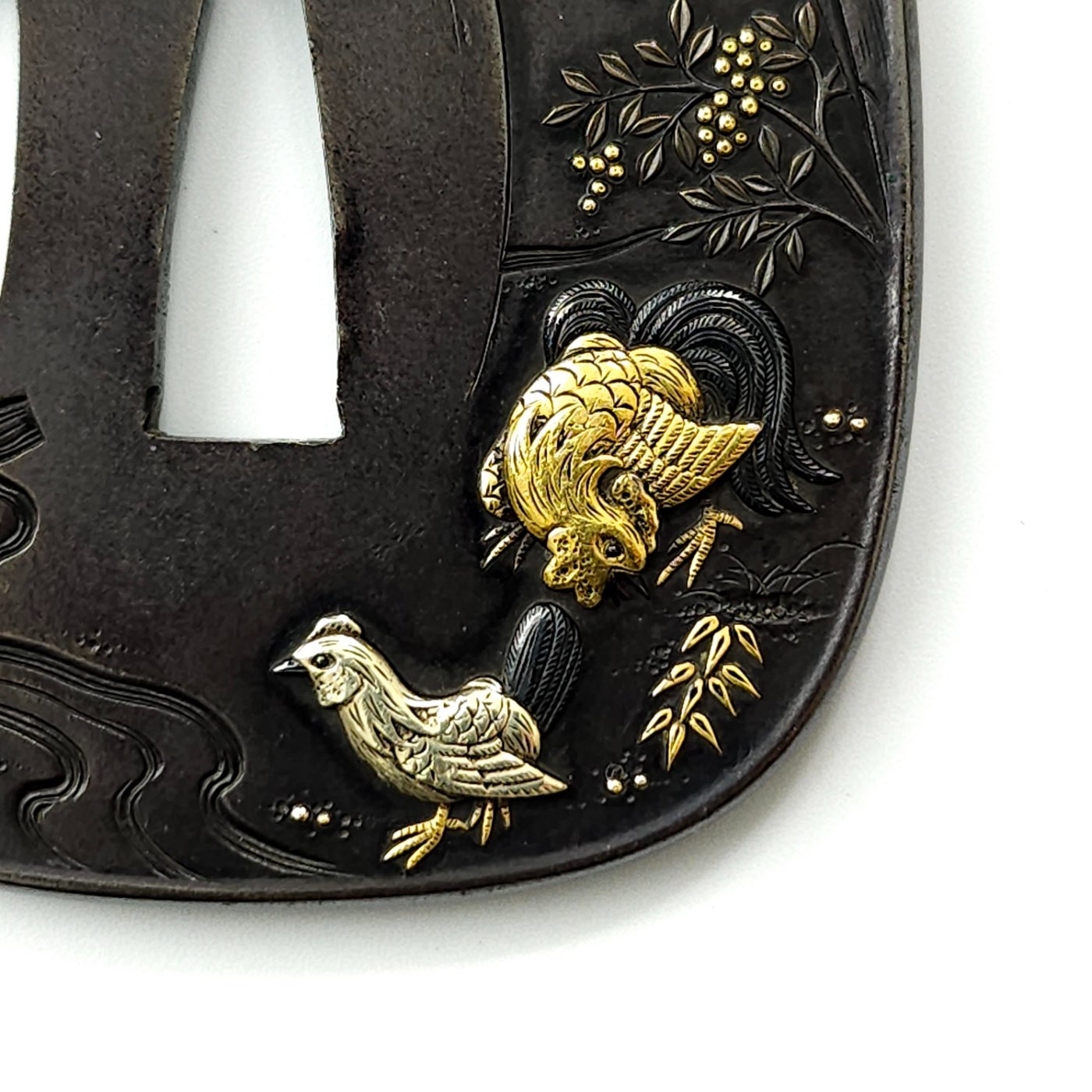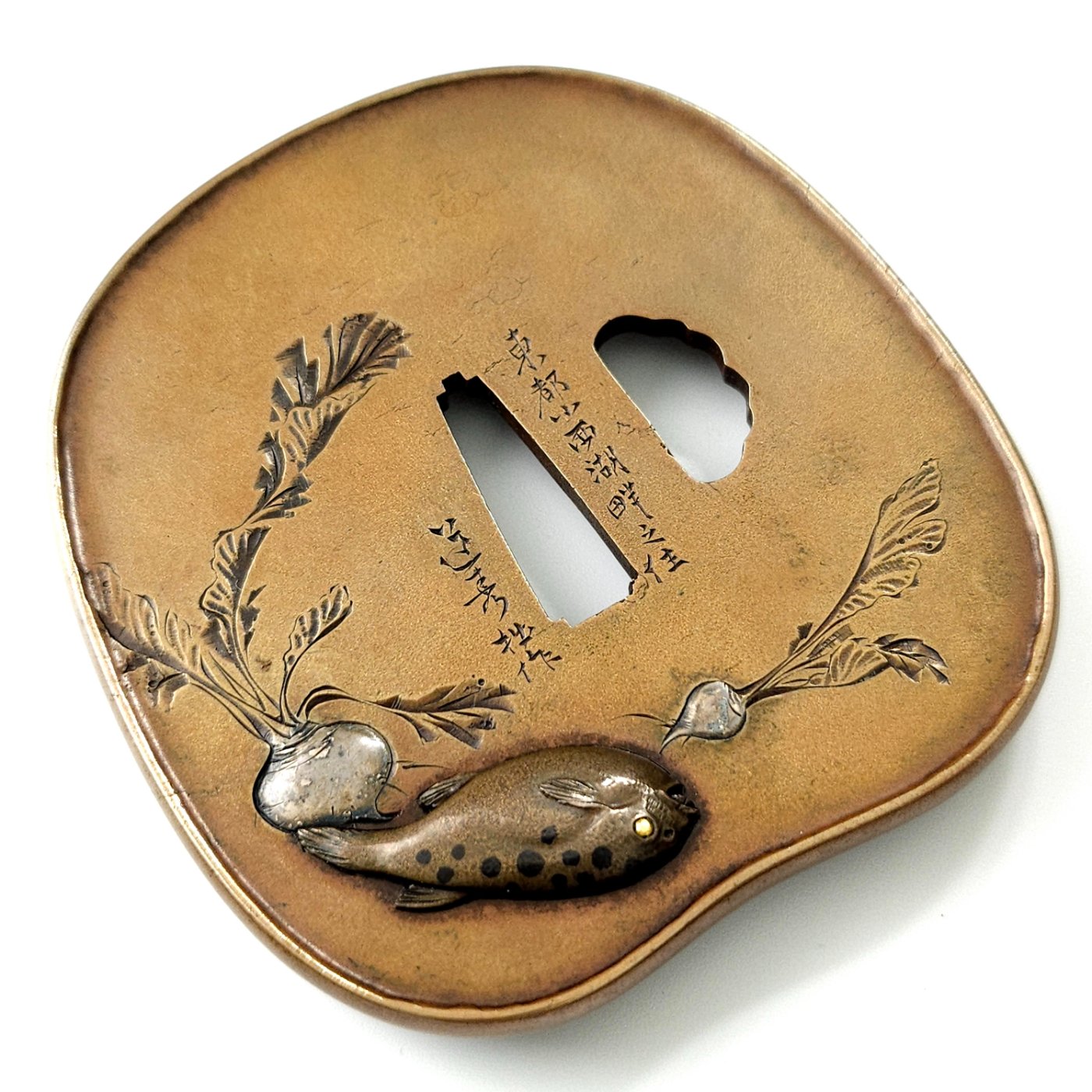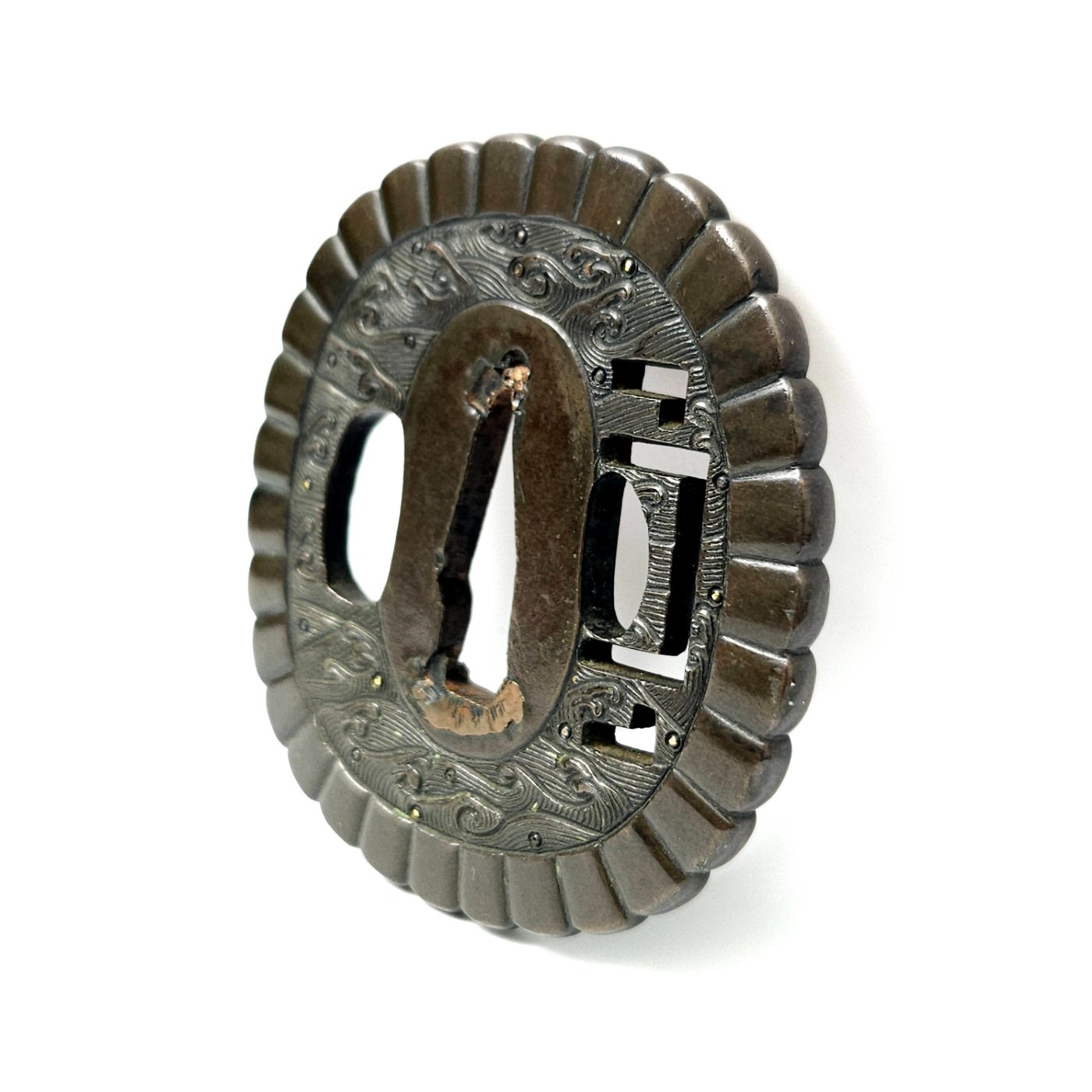
Yasuchika 1st
Iron, maru-gata, with the words 千秋萬歳 (Senshū Banzai) done in sukidashi bori on the front, with image of rain dragon on the reverse. Two hitsu-ana.
The inscription “Senshu Banzai” means literally one thousand autumns, ten thousand years, and is a wish for long life.
The name Tōu is a well-known art name for the great Yasuchika 1st (1670-1744), and there is a very famous tsuba quite similar to this one from Yasuchika, that is shown on the Iidakoendo website on link below. It links to a tsuba (now sold out) that is similar in design, and was designated Important Tōsōgu (Jūyō) in 2013. The signature for Tōu can take many forms and signature on this tsuba looks quite like the signature on the Jūyō tsuba at the shop below:
https://iidakoendo.com/4766/

 Comparison picture with Jūyō tsuba (left) from iida koendo website
Comparison picture with Jūyō tsuba (left) from iida koendo website
Yasuchika was born in the tenth year of Kanbun (寛文, 1670) as son of Tsuchiya Chûzaemon (土屋忠左衛門) who was a retainer of Dewa´s Shônai fief (庄内). His first name was „Yagohachi“ (弥五八) and with his coming of agem he entered the service of the Matsudaira-Naizen family (松平内膳), who were the elder (karô, 家老) of the Sakai family (酒井). The Sakai were the daimyô of the Shônai fief by the way. But on the side, he entered an apprenticeship as a kinkô artist with the local Shônai-Shôami artist Satô Chinkyū (佐藤珍久). When he realized that metalwork was his thing, he resigned from his bushi status, married the daughter of his master and became an independent kinkô. In the 16th year of Genroku (元禄, 1703) – he was 34 years old at that time – he left his wife and children under the care of his father-in-law and went to Edo to refine his craft under the guidance of Nara Tatsumasa (奈良辰政). This step might be connected to the fact that Chinkyû himself had studied under a Nara master, namely under Toshiharu (利治), who was in turn the master of Tatsumasa. According to transmission, Yasuchika lived at the house of a relative at that time, namely Tsuchiya Hanbei (土屋半兵衛), in Edo´s Kanda district. But the house fell victim of both fires in the 16th year of Genroku (1703) and in the second year of Hôei (宝永, 1705). So Yasuchika went to Shinano province for some years to work for the Suwa shrine (諏訪神社). But, by the latest with Hanbei´s death in Hōei four (1707), he had returned to Edo to continue his profession as a kinkô artist.
Some time later he had to bear a serious blow when he learned in Edo of the death of his wife. He hadn´t been in Shônai for more than ten years by then. But he was able to take his mind off his worries by work when he was employed in the later years of the Shôtoku era (正徳, 1711-1716) by Matsudaira Daigaku no Kami Yorisada (松平大学頭頼貞, 1664-1744). Just about ten years earlier, to be more precise in Genroku 13 (1700), Yorisada had been transferred from the Nukada fief (額田藩) of Hitachi province to Moriyama (守山藩) in Mutsu province which had become officially an independent fief whith his entry. The fief was rather small and had an annual income of 20.000 koku. Well, Moriyama was actually regarded as a so-called “shihan” (支藩), a quasi “branch fief” of another fief ruled by a different line of the same family. In our case, the Matsudaira were as we know related to the Tokugawa. So Moriyama was under the supervision of the influental Mito fief. That means that the daimyô stayed permanently in the Edo mansion and was exempt from commuting between the latter and the fief in the course of the sankin-kôtai system. The Moriyama-Matsudaira mansion was located in the Ôtsuka district (大塚) of Edo and covered a 20,46 ha large area. As the wind was blowing up constantly from the lower southwestern districts of Edo, the mansion was also called Fukiage-tei (吹上邸, about “upward wind mansion”). So Yasuchika worked from this mansion and this employment with Yorisada was very beneficial to Yasuchika´s artistic development and very individual pieces date back to that stage in his career, for example the peculiar daigaku tsuba shape named after Yorisada´s honorary title “Daigaku no Kami.
Yasuchika quit namely voluntarily this employment to work even more independently. In the meanwhile, his son Yaichirô (弥一郎) was 22 years old and so he had him come to Edo. Yasuchika married again and moved to Kanda where he trained his students. At this time – pushed by orders of famous daimyô families like the Arima (有馬) and Tsugaru (津軽) – most of his famous jûyô-bunkazai and jûyô-bijutsuhin masterworks were created. That means he had attained artistic maturity by that time. In the 15th year of Kyôhô (享保, , 1730) he entered priesthood at the age of 61 and called himself henceforth „Tōu“ (東雨, lit. “Eastern Rain”). He handed-over the management of the family and his name „Yasuchika“ as well as his first name „Yagohachi“ to his son Yaichirô. In Genbun three (元文, 1738) his second wife died and from extant letters to his kinkô colleague Watanabe Arichika (渡辺在哉), who worked in his homeland Shônai, we learn that Yasuchika often had to stay in bad due to his bad physical condition. And in these hard times, the last tsuba was made which was representative for his latest years. It is as indicated no longer signed “Yasuchika” but “Tōu” and shows on a very gentle nadekaku-gata, by making use of much free space, the three elegantly interpreted characters “Kongô´ô“ (金剛王). Kongô´ô can either be the abbreviation of „Kongô-yasha-myôô“ (金剛夜叉妙王, sanskrit „Vajrayakṣa“), one of the „Sixteen Great Bodhisattva“ and one of the „Five Great Myôô“, or of the Bodhisattva „Kongô-za´ô“ (金剛蔵王), one of the most important deities of the practitioners of shûgendô (修験道). So it is possible that Yasuchika increasingly turned towards Buddhism when he fell ill, namely as support for his prayers for health and inner peace, as spiritual backing for keeping-off demoniacal hindrances (mashô, 魔障) during meditation. Yasuchika died six years after his second wife, namely on the 27th day of the ninth month of Enkyô one (延享, 1744), at the age of 75.
(Source: Markus Sesko)
Mei/signature:
Tōu (東雨)
Later inscription by Yasuchika
School/province:
Nara – Yasuchika branch
Dewa Province (Yamagata Prefecture)
Period/age:
Edo, 1730-1744
Yasuchika changed his inscription to Tōu from 1730 until his death in 1744
Measures:
7.40 cm x 7.40 cm x 0.45 cm at nakago-ana (0.50 cm at mimi)
Certificate:
No
Included:
NO kiri box included





















